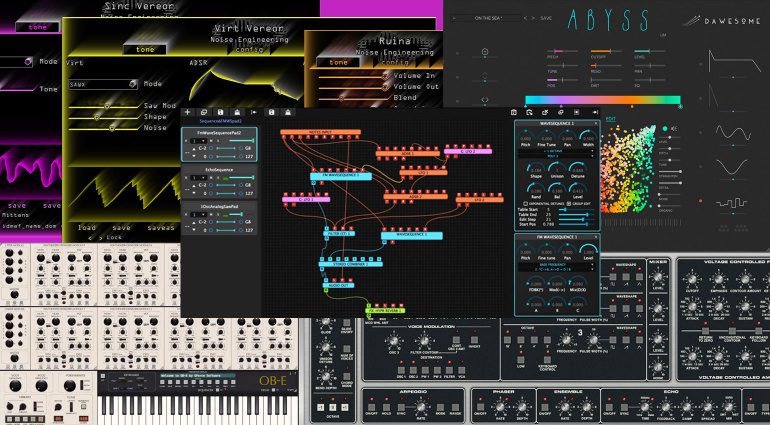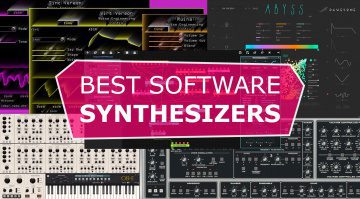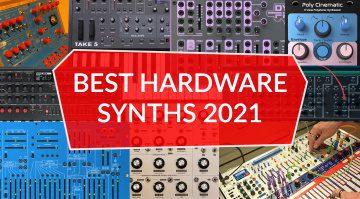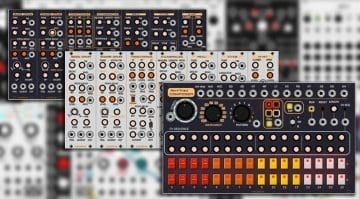Best Virtual Synthesizers 2021: The Top 5 software synths of the year (so far)
We all have our favourite go-to software synthesizers – but what are the new breakthrough synths of the year so far? Here are five for your consideration.
Wavesequencer Hyperion
Hyperion somehow manages to bring together a complex arrangement of modular synthesis, audio nodes and deep control into a very playable multi-layered and enjoyable synthesizer. It should be a lot more complicated than it is, I mean that interface is enough to scare people off, but once you start playing the presets you’ll find it’s astonishingly good.
The interface could be a barrier but actually, once you start peeling back the layers you’ll find it’s very logical and has an enormous amount of power. Each node has a familiar-looking synth panel for parameter adjustment and you can very quickly build up fascinating amounts of modulation and manipulation. And you’ll find every type of sound design tool you could possibly imagine in here.
Hyperion has sound generators ranging from simple waveforms to 4 operator FM, Soundfonts, multisamples and physical modelling. You can even add wave sequencing up to 32 steps. And if it all gets a bit boggling then you can spend time with the excellent range of presets or spend some time with the simple building blocks of synthesis and start there.
It sounds great, is in constant development and is a fascinating playground of synthesis and sound design.
You are currently viewing a placeholder content from YouTube. To access the actual content, click the button below. Please note that doing so will share data with third-party providers.
Dawsome Abyss
Weird, strange and visually arresting is the wonderful world of Abyss. It uses a unique Tone Colour Gradient to visualise the sonic qualities of the synthesis and sound generation in a very interactive interface. It has a serious cinematic vibe going on while still giving the impression of playfulness and creativity.
The swarm of colour brings in 2000 possibilities that get manipulated and categorised through their hue as represented on the Gradient Bar. You then control movement along the bar which in turn morphs and modulates it’s way through the evolving textures. It’s quite fascinating.
There are waveforms to morph and sync, LFOs to patch in smoothly or in steps and envelopes that can change the game as you play. It’s marvellously organic and yet other-worldly.
Abyss is the most surprising synth I’ve seen this year.
You are currently viewing a placeholder content from YouTube. To access the actual content, click the button below. Please note that doing so will share data with third-party providers.
- Abyss webpage
Noise Engineering Sinc Vereor and Virt Vereor
Ok, so it’s two synths but they are based on the same engine but use different algorithms. They come together for free and are both stunningly good in a raw and juicy kind of way. They come from Noise Engineerings digital oscillator Eurorack modules which make them immediately quirky and a bit different from the norm.
Sinc Vereor is deceptively simple with classic waveforms and a handful of familiar synthy controls. However, there are different modes that have a habit of pulling sound apart and rebuilding it in deliciously animated and exciting ways. You’ll find noise, percussion, effects and a Super mode that adds 6 phase-offset oscillators for a big evolving sound.
Virt Vereor has a unique set of algorithms featuring Bass, Quadrature, SawX and Harm all of which found themselves in the Arturia MicroFreak V3 update.
The “Vereor” section of each synth builds in the dynamics that the original modules didn’t have. So the envelope, the VCA and an intense filter with a nicely wobbly chorus. It’s all wrapped up in a zany interface that can only add to the madness.
What’s brilliant about them is how simple and perfectly poised they are. These are not huge enveloping synths that will wrap you in a blanket of sound, these are sharp, useful algorithms that’ll sequence brilliantly and cut through a mix. As a bonus they also come with a distortion plugin.
You are currently viewing a placeholder content from YouTube. To access the actual content, click the button below. Please note that doing so will share data with third-party providers.
- Noise Engineering website.
- Noise Engineering blog post.
- More Noise Engineering news
Cherry Audio Memorymode
If you’re going to emulation a legendary old synthesizer then why not tackle the big one; the Memorymoog? With Memorymode Cherry Audio has attempted to capture the mother of all polysynths. They used a vintage machine owned by jazz legend Chick Corea as the basis of their analysis and spent a lot of time doing detailed models of the 3-oscillator architecture, ladder filter and overdrive.
You have 16 voices to play with, a selectable 12dB or 24dB/octave filter, tempo-synced LFO, detunable unison mode with up to 48 oscillators and an improved arpeggiator. They’ve expanded the modulation section to give you more movement and they’ve added studio-quality effects like phaser, ensemble, delay and reverb.
It comes with 600 presets in case you want to know what it’s supposed to sound like and the general consensus is that it sounds pretty darn good. Cherry Audio has added MPE support for expressive playing and done innovative things with the GUI to bring the bits you’re working on into focus. It’s not trying to be anything other than a homage to a great synth and there are hours of joy to be had in here.
Cherry Audio has produced a bunch of great software emulations over the past year and all of them sound great for a small handful of dollars.
You are currently viewing a placeholder content from YouTube. To access the actual content, click the button below. Please note that doing so will share data with third-party providers.
GForce OB-E
GForce has an awesome reputation for capturing the essence of hardware synths in software form. So when they released OB-E to take on the mighty Oberheim 8-Voice, you just knew it was going to be something special. The 8-Voice was essentially 8 Oberheim SEM modules wired together to form an 8-voice polyphonic synthesizer. It was physically huge and uncompromising and came about before anyone had worked out how to use a single control to change all the parameters of a polyphonic synth. So you had to tune all the oscillators manually, change each filter for each module, each envelope and so on. It created a lot of work but also a very unique sound.
GForce calls it an “authentic sounding emulation” and it is completely magnificent. It captures the essential qualities of the SEM module and pulls it together into a fat and juicy synthesizer.
The beauty of software is that you can make things a bit easier. So while you can fill your boots with the individual controls you can also apply any changes to all the modules at once. The interface also zooms in to help you focus on a particular module. There are mono, poly and unison modes, an additional LFO, velocity, aftertouch and MPE. They’ve also stuck in an 8-step sequencer and stereo delay.
The OB-E is a beautiful instrument that is a joy to explore. The only snag is that it’s currently only available on macOS.
https://youtu.be/XrJJpN1a8w0
Your top 5?
So there you are, 5 amazing software synthesizers covering all sorts of concepts with the bizarre Abyss, the complex Hyperion, the nutty and useful algorithms of Noise Engineering and the gorgeously warm and familiar tones of the Memorymode and OB-E. A good range of possibilities in these ones I think. What would have your choices been? Let us know in the comments.
4 responses to “Best Virtual Synthesizers 2021: The Top 5 software synths of the year (so far)”
 3,0 / 5,0 |
3,0 / 5,0 | 







My top 5: VCV Rack, Vital, Dexed, Surge and TyrellN6.
Pretty much all I need.
My Top 5 Virtual Instruments are and have been (and in no particular order – just absolute go-to).
1. VPS Avenger
2. Reveal Sound Spire
3. Arturia Jup-8 V
4. U-He Diva
5. LennarDigital Sylenth1
If they release a version from Avenger without their included tons of other software to protect this single synth I would say you are right. But at the moment a lot of cpu usage Avenger produces comes from unneeded background software.
Arturia V Collection 7 rocks my world. Love the Buchla Fairlight and CS-80 emulations…